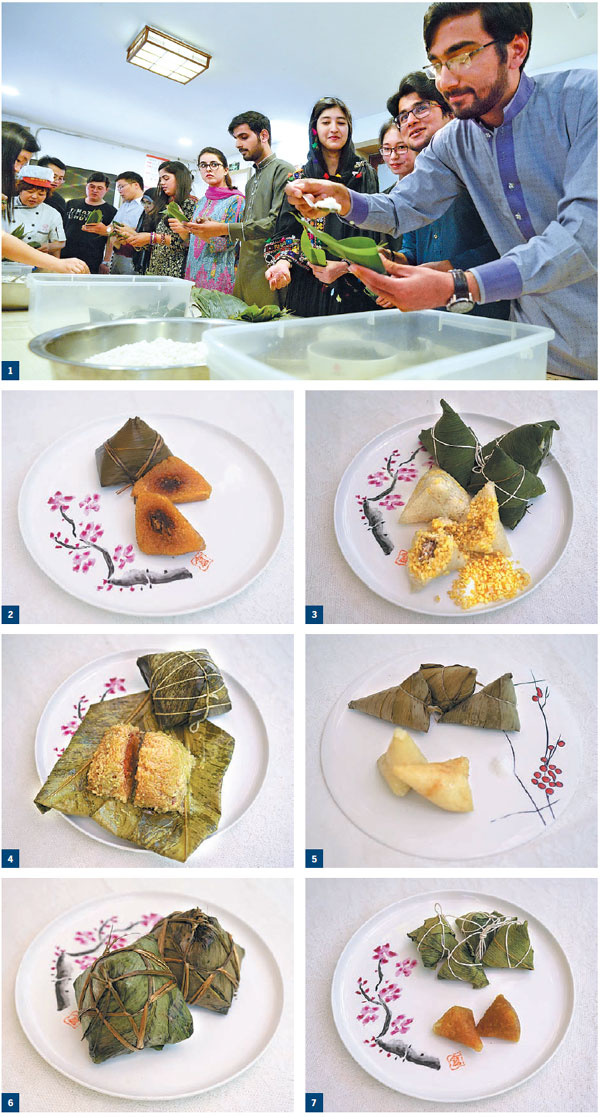Studying the evolution of sticky rice dumplings
Every major festival in China has its dedicated food speciality, and for the Dragon Boat Festival in the fifth lunar month, it has to be rice dumplings, or zongzi.
The first dumplings were simple offerings to gods and ancestors. Grain was tightly wrapped in reeds and then boiled. These simple packages were then placed upon the altars of the early deities, and on the graves of the dead.
This was as far back as the Spring and Autumn Period (770 - 476 BC).
Sticky millet was the first cereal to be used, but rice, mainly the glutinous variety, slowly became the grain of choice.
It was only during the Warring States Period (475-221 BC) a little later that rice dumplings became associated with the story of Qu Yuan, the poet and minister, who famously committed suicide by jumping into the Miluo River in protest against corruption and debauchery at court.
The people loved him, even if his king and peers did not, and they started throwing dumplings into the river to appease the spirit of this valiant poet-patriot. Some say the dumplings were to keep the fishes away from his body, and that dragon boats were launched in the search for his remains.
Now, more than 2,000 years later, dragon boats still take to the water each year in races, and the tradition of making dumplings continues. However, people no longer toss the dumplings into the river. Instead, they celebrate and commemorate the folk hero by eating them.
So it is that the dumplings themselves have evolved to suit different regions, times and tastes, and they have come a very long way from the simple reed-wrapped packages of the ancient past.
They are made in a variety of grains, fillings in four- or five-sided pyramids or huge pillow-sized packages. The great taste divide between north and south, too, manifests itself in the marked preference for sweet or savory dumplings.
North of the Yangtze, they prefer them sweet and simple, while southerners in Shanghai right down to Guangdong like their rice dumplings stuffed full of savory delicacies.
The North's famous sweet tooth commands most of the market and the first dumplings made here were from sticky yellow millet stuffed with a single candied Chinese jujube.
Later, sweet red or adzuki beans became popular. They were mixed into white glutinous rice for color contrast and flavor, wrapped and boiled, before being dipped into sugar. In later, more prosperous times, the beans were cooked into a paste which became a filling for the dumplings.
In the last 30 years or so, Beijing dumplings are starting to feature a more elaborate variety of sweet ingredients, including candied flageolet beans, mung beans, chestnuts, hawthorn fruit, candied dates, candied winter melon strips and dried apricots - most of which are locally produced. A current "health" trend also has dumplings made from mixed grains and beans such as corn, peas, millet, sorghum and buckwheat mixed into the base of sticky rice.
Perhaps the most characteristic dumpling from Beijing would have to be the plain glutinous rice dumpling with a ball of sweet red bean paste inside.
It is in the provinces and regions south of the mighty Yangtze that dumplings are produced all year round with production peaking before the fifth lunar month. This is in the county of Jiaxing.
The History Annals record that Jiaxing was producing dumplings as far back as Western Zhou Dynasty (c.11th century-771 BC), with rice carefully infused with the fragrance of bamboo leaf, mugwort, and tea. These primitive dumplings were filled with dried jujubes, corn, mung beans and barley.
Some of the Jiaxing recipes are still popular to this day, including a sweet tea-infused dumpling using the best leaves from Fujian province's Mecca of tea, Wuyi Mountain.
However, Jiaxing's most popular offering is still a savory dumpling stuffed with seasoned pork and salted egg yolk.
More luxurious versions feature Jinhua ham, a regional speciality.
As we travel further south, the rice is stuffed with more and more exotic ingredients, although there is still a definite slant towards savory dumplings.
The ultimate deluxe dumpling must be the Cantonese edition. The glutinous rice is flavored with fried garlic and soy sauce, giving the rice a shiny brown sheen.
Hidden inside are generous chunks of seasoned pork belly, braised mushrooms, dried scallops, chestnuts, lotus seeds, peanuts, skinned mung beans and often, a deep golden-orange salted egg yolk.
These are wrapped in giant bamboo or lotus leaves, and big enough to make man-sized meals.
There are more delicate dumplings, of course.
In Sichuan, they like little plain rice dumplings which they eat dipped in white sugar.
Elsewhere, in Shanghai, Fujian, Guangzhou and Chaoshan, they soak the glutinous rice in an alkaline solution. This turns the rice grains golden yellow, and they become very chewy when cooked.
These little bouncy golden dumplings are sometimes stuffed with red bean paste, but are more often than not eaten as they are, dipped into golden syrup, honey or granulated sugar.
Of course, with the entry of international hotels into the vast Chinese market, the threshold for unique dumplings has been kicked up several notches. Truffles, lobsters, abalone, Kurobuta pork, Iberian ham - nothing is too luxurious for these five-star dumplings.
Considering the historic roots of these originally humble packets of leaf-wrapped rice, we cannot help but wonder what the ancients would have thought of this new-aged decadence.
|
1. International students at Hebei University of Engineering enjoy making rice dumplings with their Chinese teachers and classmates on May 22. 2. Guangdong golden dumplings with sweet bean paste Gan shui chung, or alkaline dumplings, are a translucent golden yellow, with a ball of red bean paste in the middle. 3. Cantonese mung bean dumpling A favorite breakfast dumpling all year round. Softened mung beans are stuffed into glutinous rice. For seasoning, a small cube of pork fat is rolled in fragrant five-spice powder and placed in the center. 4. Hainan black pig dumpling This hearty dumpling is a Ding'an specialty made using the region's prized pork. 5. Sichuan white dumplings Plain glutinous rice is all it takes to make these dumplings special. 6.Jiaxing Dumplings The most famous Jiaxing dumpling is the savory pork dumplings, but there are also sweet dumplings filled with candied jujubes and red bean paste to cater to a wider audience. 7. Little golden dumplings made by soaking rice in an alkali solution. First Photo by Hao Qunying and other photos by Bao Donghai / For China Daily |



















